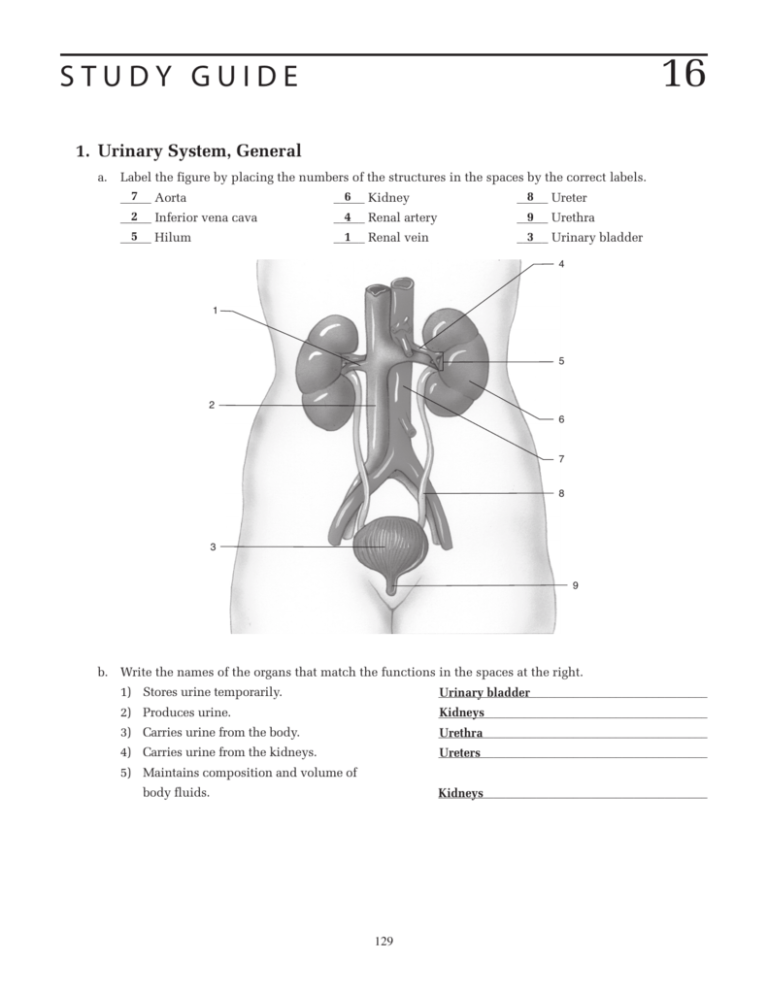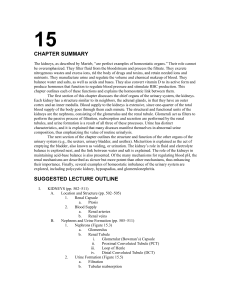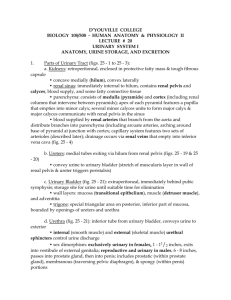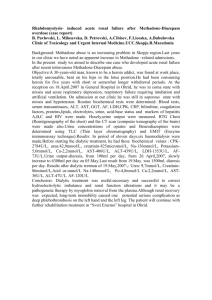STUDY GUIDE
advertisement

16 STUDY GUIDE 1. Urinary System, General a. Label the figure by placing the numbers of the structures in the spaces by the correct labels. 7 Aorta 6 Kidney 8 Ureter _____ _____ _____ 2 Inferior vena cava _____ 5 Hilum _____ 4 Renal artery _____ 9 Urethra _____ 1 Renal vein _____ 3 Urinary bladder _____ 4 1 5 2 6 7 8 3 9 b. Write the names of the organs that match the functions in the spaces at the right. 1) Stores urine temporarily. ____________________________________________ Urinary bladder 2) Produces urine. ____________________________________________ Kidneys 3) Carries urine from the body. ____________________________________________ Urethra 4) Carries urine from the kidneys. ____________________________________________ Ureters 5) Maintains composition and volume of body fluids. ____________________________________________ Kidneys 129 2. Kidneys a. Write the names of the structures that match the statements in the spaces at the right. 1) Outer layer containing renal corpuscles. ____________________________________________ Cortex 2) Region containing renal pyramids. ____________________________________________ Medulla 3) Flattened cavity continuous with ureter. ____________________________________________ Pelvis 4) Receptacles surrounding renal papillae. ____________________________________________ Calyces 5) Thin layer of connective tissue enveloping ____________________________________________ Renal capsule kidney. 6) Arterial capillaries in renal corpuscle. ____________________________________________ Glomerulus 7) Functional units of the kidneys. ____________________________________________ Nephrons 8) U-shaped portion of renal tubule. ____________________________________________ Loop of Henle 9) Part of renal tubule joined to glomerular capsule. ____________________________________________ Proximal convoluted tubule 10) Part of renal tubule joined to a collecting duct. ____________________________________________ Distal convoluted tubule 11) Formed of modified cells at point of contact of distal tubule and afferent arteriole. ____________________________________________ Juxtaglomerular apparatus b. Label the figure by placing the numbers of the structures in the spaces by the correct labels. 4 Calyx _____ 1 2 Renal capsule _____ 2 6 Renal column _____ 3 1 Renal cortex _____ 3 Renal medulla _____ 4 7 Renal papilla _____ 5 Renal pelvis _____ 5 6 7 8 9 130 8 Renal pyramid _____ 9 Ureter _____ c. Label the figure by placing the numbers of the structures in the spaces by the correct labels. 1 7 6 3 Afferent arteriole _____ 9 Collecting duct _____ 2 7 Distal convoluted _____ tubule 3 2 Efferent arteriole _____ 1 Glomerular capsule _____ 6 Glomerulus _____ 5 Nephron loop _____ 8 Peritubular capillary _____ 4 Proximal _____ convoluted tubule 4 8 5 9 3. Urine Formation a. Write the words that complete the sentences in the spaces at the right. A decrease in the glomerular filtration rate 1) Juxtaglomerular ___________________________________________ causes the ____1___ apparatus to secrete 2) Renin ___________________________________________ ____2___ , which triggers the ____3___- ___________________________________________ 3) Renin ____4___ mechanism. The end product of 4) Angiotensin ___________________________________________ these reactions is ____5___ , which increases 5) Angiotensin ___________________________________________ II systemic blood pressure by ____6___ arteri- 6) Constricting ___________________________________________ oles, stimulating ____7___ secretion by the ___________________________________________ 7) ADH posterior pituitary, and stimulating ____8___ 8) Aldosterone ___________________________________________ secretion by the adrenal cortex. b. Write the terms that match the statements in the spaces at the right. 1) Passage of water and solutes from glomerulus into glomerular capsule. ____________________________________________ Filtration 2) Plasma component that cannot pass through glomerular pores. ____________________________________________ Proteins 3) Force producing filtration. ____________________________________________ Glomerular blood pressure 4) Fluid in glomerular capsule. ____________________________________________ Filtrate 5) Recovery of needed materials from filtrate into the blood. ____________________________________________ Tubular reabsorption ____________________________________________ 180 liters 6) Volume of filtrate formed per day. 131 7) Method of transport of sodium ions. ____________________________________________ Mostly active transport 8) Method of transport of water. ____________________________________________ Osmosis 9) Method of transport of glucose. ____________________________________________ Active transport 10) Method of transport of chloride ions. ____________________________________________ Mostly passive electro-chemical attraction 11) Substance reabsorbed that concentrates the urine. ____________________________________________ Water 12) Passage of substances from blood into the filtrate. c. ____________________________________________ Tubular secretion 13) Actively secreted ion. ____________________________________________ H 14) Passively secreted ion. ____________________________________________ K Indicate whether each statement is true (T) or false (F). _____ T Urine contains waste and excessive materials removed from the blood. _____ T Urine formation depends upon maintenance of the blood pressure within the glomeruli. _____ T Most of the filtrate volume is reabsorbed. _____ T Negatively charged ions and positively charged ions are electrochemically attracted to each other. _____ T The active reabsorption of sodium ions increases the rate of water reabsorption by osmosis. 4. Maintenance of Blood Plasma Composition a. Write the terms that match the statements in the spaces at the right. 1) Hormone promoting water reabsorption. 2) Hormone promoting reabsorption of Na . 3) Hormone promoting secretion of K. . 4) Hormone decreasing blood level of Ca 5) Hormone increasing blood level of Ca . ____________________________________________ Antidiuretic hormone ____________________________________________ Aldosterone ____________________________________________ Aldosterone ____________________________________________ Calcitonin ____________________________________________ Parathyroid hormone ____________________________________________ Urea 6) Three nitrogenous wastes in urine. ____________________________________________ Uric acid ____________________________________________ Creatinine b. Indicate whether each statement is true (T) or false (F). F Cellular activity does not affect plasma composition. 1) _____ T Plasma composition is changed by the work of kidneys. 2) _____ F Electrolytes are totally reabsorbed into the blood. 3) _____ T About 99% of water in the filtrate is reabsorbed. 4) _____ 5) _____ F Water is lost from the body only in urine. 6) _____ T Urine volume is reduced when water intake is curtailed. 7) _____ T Perspiring heavily may reduce the volume of urine. 8) _____ T Electrolyte balance is largely maintained by the active reabsorption of positively charged ions. 9) _____ F Nephrons remove all nitrogenous wastes from the blood. 10) _____ T Urea is the most abundant nitrogenous waste in urine. 11) _____ F Urea is formed by the kidneys from amine groups. 12) _____ T Buffers are chemicals in body fluids that either combine with or release hydrogen ions. 13) _____ F The production of carbon dioxide by metabolizing cells tends to make the blood more alkaline. 132 14) _____ T Kidneys help to regulate the pH of body fluids by secreting excess hydrogen ions into the filtrate. T Water and electrolyte balance in body fluids is essential for normal cell functioning. 15) _____ T ADH is released by the posterior pituitary gland when the water concentration of the blood 16) _____ is reduced. F Aldosterone is secreted by the adrenal cortex when the concentration of K in the blood is 17) _____ reduced. 18) _____ T ADH increases the permeability of the distal tubules and collecting ducts to water. 19) _____ T Electrolyte concentrations in the blood affect the movement of water into cells by osmosis. 5. Excretion of Urine a. Write the terms that match the statements in the spaces at the right. 1) Carry urine to urinary bladder. ____________________________________________ Ureters 2) Provides temporary storage of urine. ____________________________________________ Urinary bladder 3) Muscle in wall of urinary bladder. ____________________________________________ Detrusor muscle 4) Carries urine from urinary bladder. ____________________________________________ Urethra 5) Method of urine transport by ureters. ____________________________________________ Peristalsis 6) Type of muscle composing the internal urethral sphincter. ____________________________________________ Smooth muscle 7) Type of muscle composing the external urethral ____________________________________________ Skeletal muscle sphincter. ____________________________________________ Smooth muscle 8) Type of muscle in walls of ureters. b. Write the words that complete the sentences in the spaces at the right. The accumulation of ____1___ stretches the 1) ___________________________________________ Urine urinary bladder wall, which triggers the 2) ___________________________________________ Micturition reflex ____2___ reflex. This reflex causes rhythmic 3) ___________________________________________ Detrusor involuntary contractions of the ____3___ mus- 4) ___________________________________________ Internal cle and opens the involuntarily controlled 5) ___________________________________________ External ____4___ urethral sphincter. If the voluntarily 6) ___________________________________________ Micturition controlled ____5___ urethral sphincter is relaxed, ____6___ occurs. 6. Characteristics of Urine Indicate whether each statement is true (T) or false (F). 1) _____ T The color of urine is due to the presence of urochrome. 2) _____ T The pH of urine is usually slightly acidic. 3) _____ F Normal urine is never alkaline. 4) _____ T Urine has a specific gravity greater than 1.000. 5) _____ T Normal urine does not contain proteins or hemoglobin. 133 7. Disorders of the Urinary System Write the names of the disorders matching the statements in the spaces at the right. 1) Inflammation of the glomeruli. ____________________________________________ Glomerulonephritis ____________________________________________ Cystitis 2) Inflammation of the urinary bladder. 3) Inflammation of nephrons and renal pelvis. ____________________________________________ Pyelonephritis ____________________________________________ Diuresis ____________________________________________ Renal calculi 4) Excessive urine production. 5) Kidney stones. 6) Inflammation of the urethra. ____________________________________________ Urethritis ____________________________________________ Renal Calculi 7) Deposits of uric acid in the renal pelvis. 8) Characterized by uremia. ____________________________________________ Renal failure ____________________________________________ Glomerulonephritis 9) Characterized by protein in the urine. 8. Clinical Applications a. A 60-year-old woman comes to the clinic with severe edema of her lower legs and feet. A diuretic is prescribed, and she is placed on a salt-free diet. She is also advised to take a 30-minute walk each morning and afternoon and to elevate her feet higher than her head for 20-minute periods morning and afternoon. Explain how the diuretic will reduce her edema. __________________________________ The diuretic counters the action of _____________________________________________________________________________________________ ADH to increase the excretion of water. As the concentration of water in blood decreases, more _____________________________________________________________________________________________ interstitial fluid is reabsorbed into the blood and then excreted by the kidneys. _____________________________________________________________________________________________ Explain how the salt-free diet will help reduce her edema. _______________________________________ Decreasing salt intake decreases the _____________________________________________________________________________________________ osmotic pressure of body fluids and reduces blood volume which helps the removal of excessive _____________________________________________________________________________________________ interstitial fluid. _____________________________________________________________________________________________ Explain how elevating her feet and walking will help reduce her edema. ___________________________ Elevating the feet uses _____________________________________________________________________________________________ gravity to aid the return of venous blood and lymph, and contractions of leg muscles propels venous _____________________________________________________________________________________________ blood and lymph upward. The improved circulation of blood and movement of lymph aids removal of _____________________________________________________________________________________________ excess interstitial fluid. b. Explain why women develop cystitis more frequently than men. __________________________________ The shorter female urethra makes it _____________________________________________________________________________________________ easier for bacteria to enter the urinary bladder. _____________________________________________________________________________________________ 134








